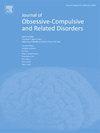拔毛癖和抠皮障碍患者行为和接受问卷的心理测量学特征
IF 1.5
4区 医学
Q3 PSYCHIATRY
Journal of Obsessive-Compulsive and Related Disorders
Pub Date : 2025-08-28
DOI:10.1016/j.jocrd.2025.100972
引用次数: 0
摘要
自我报告问卷可用于评估接受与承诺强化行为疗法(ACT-enhanced BT)治疗拔毛癖(TTM)和抠皮障碍(SPD)的治疗过程和结果。TTM的行动和接受问卷(AAQ-4TTM)评估TTM患者的经验回避,可以很容易地适用于SPD患者,将“拔头发”改为“抠皮肤”。本研究旨在评估AAQ-4TTM的心理测量特性,包括因子结构、因子负荷、内部一致性和结构效度,在寻求治疗的TTM或SPD个体样本中。我们预计在两个诊断组的因素结构和其他心理测量特性上没有差异。研究样本包括244例原发性诊断为TTM (n = 144)或SPD (n = 100)的患者,所有患者均接受act增强BT评估。与我们的预测相反,探索性因素分析显示SPD组与TTM组的因素结构不同。TTM组出现双因素结构,SPD组出现一维结构。在TTM中,这两个因素被标记为“接受”和“干扰”。干扰因子比接受因子与精神病理指标的相关性更强。SPD因子,标记为“灵活性”,显示出与自我报告的抠皮严重程度最强的相关性。虽然AAQ-4TTM的心理测量特性不是最优的,但在TTM组中发现的两个因素似乎代表了ACT框架内有意义的构式。在SPD组中,AAQ-4SPD似乎是一个单向度的量表,反映了心理灵活性。本文章由计算机程序翻译,如有差异,请以英文原文为准。
Psychometric properties of the action and acceptance questionnaire for trichotillomania in a clinical sample of patients with trichotillomania and skin picking disorder
Self-report questionnaires can be valuable for evaluating treatment processes and outcomes in Acceptance and Commitment Therapy enhanced Behavioral Therapy (ACT-enhanced BT) for trichotillomania (TTM) and skin picking disorder (SPD). The Action and Acceptance Questionnaire for TTM (AAQ-4TTM) assesses experiential avoidance in individuals with TTM and can be easily adapted for patients with SPD by replacing references to “hair pulling” with “skin picking.” This study aims to evaluate the psychometric properties of the AAQ-4TTM, including factor structure, factor loadings, internal consistency, and construct validity, in a treatment-seeking sample of individuals with TTM or SPD. We expected no differences in factor structure and other psychometric properties across the two diagnostic groups. The study sample comprised 244 patients with a primary diagnosis of TTM (n = 144) or SPD (n = 100), all of whom were evaluated for ACT-enhanced BT. Contrary to our prediction, the exploratory factor analyses revealed different factor structures for the SPD group compared to the TTM group. While a two-factor structure emerged in the TTM group, a unidimensional structure was found in the SPD group. In TTM, the two factors were labeled “Acceptance” and “Interference”. The Interference factor showed stronger associations with measures of psychopathology than the Acceptance factor. The SPD factor, labeled “Flexibility”, showed the strongest correlation with self-reported skin-picking severity. Although the psychometric properties of the AAQ-4TTM were not optimal, the two factors identified in the TTM group seem to represent meaningful constructs within the ACT framework. In the SPD group, the AAQ-4SPD appears to function as a unidimensional scale, reflecting Psychological flexibility.
求助全文
通过发布文献求助,成功后即可免费获取论文全文。
去求助
来源期刊
CiteScore
4.00
自引率
5.60%
发文量
46
审稿时长
47 days
期刊介绍:
Journal of Obsessive-Compulsive and Related Disorders (JOCRD) is an international journal that publishes high quality research and clinically-oriented articles dealing with all aspects of obsessive-compulsive disorder (OCD) and related conditions (OC spectrum disorders; e.g., trichotillomania, hoarding, body dysmorphic disorder). The journal invites studies of clinical and non-clinical (i.e., student) samples of all age groups from the fields of psychiatry, psychology, neuroscience, and other medical and health sciences. The journal''s broad focus encompasses classification, assessment, psychological and psychiatric treatment, prevention, psychopathology, neurobiology and genetics. Clinical reports (descriptions of innovative treatment methods) and book reviews on all aspects of OCD-related disorders will be considered, as will theoretical and review articles that make valuable contributions.
Suitable topics for manuscripts include:
-The boundaries of OCD and relationships with OC spectrum disorders
-Validation of assessments of obsessive-compulsive and related phenomena
-OCD symptoms in diverse social and cultural contexts
-Studies of neurobiological and genetic factors in OCD and related conditions
-Experimental and descriptive psychopathology and epidemiological studies
-Studies on relationships among cognitive and behavioral variables in OCD and related disorders
-Interpersonal aspects of OCD and related disorders
-Evaluation of psychological and psychiatric treatment and prevention programs, and predictors of outcome.

 求助内容:
求助内容: 应助结果提醒方式:
应助结果提醒方式:


